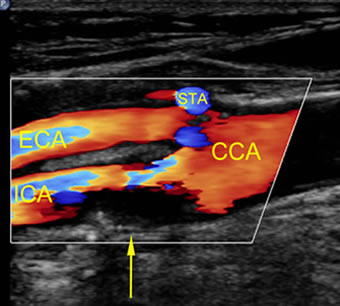Summary
Definition
History and exam
Key diagnostic factors
- asymptomatic
- cervical bruit
- focal neurological deficit lasting >24 hours (i.e., stroke)
- focal neurological deficit lasting <24 hours (i.e., transient ischaemic attack [TIA])
Risk factors
- older age
- smoking
- history of cardiovascular disease
- history of hypertension
- history of hypercholesterolaemia
- diabetes
Diagnostic investigations
1st investigations to order
- duplex ultrasonography
- computed tomography angiography (CTA) of head, neck, and chest
Investigations to consider
- magnetic resonance angiography (MRA) of head, neck, and chest
- CT brain
- MRI brain
Treatment algorithm
Contributors
Authors
Brajesh K. Lal, MD, FACS
Professor of Vascular Surgery
University of Maryland School of Medicine
Professor of Neurology
Mayo Clinic
Chief of the Vascular Service
Baltimore VA Medical Center
Baltimore
MD
Disclosures
BKL declares that he has a grant from the National Institutes of Health, Bethesda, MD, USA to conduct a multicenter study comparing revascularisation to medical management for asymptomatic carotid stenosis.
Richard Bulbulia, MA, MD, FRCS
Associate Professor and Consultant Vascular Surgeon
Clinical Trial Service Unit and MRC Population Health Research Unit
Nuffield Department of Population Health
University of Oxford
Oxford
UK
Disclosures
RB declares that he has no competing interests.
Acknowledgements
Dr Brajesh K Lal and Dr Richard Bulbulia would like to gratefully acknowledge Professor Martin M Brown, a previous contributor to this topic.
Peer reviewers
Tristan RA Lane, MBBS, BSc, PhD, FRCS
Consultant Vascular Surgeon
Cambridge Vascular Unit
Addenbrooke's Hospital
Cambridge University Hospital Trust
Cambridge
Honorary Senior Clinical Lecturer, Section of Vascular Surgery
Department of Surgery and Cancer
Imperial College London
UK
Disclosures
TRAL declares that he has no competing interests.
Use of this content is subject to our disclaimer
